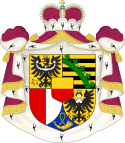From Wikipedia, the free encyclopedia
1973 Liechtenstein women's suffrage referendum Location Liechtenstein
Response
Votes
%
1,675
2,126
Valid votes
3,801
Invalid or blank votes
55
Total votes
3,856
100.00%
Registered voters/turnout
4,483
1973 Liechtenstein electoral system referendum Location Liechtenstein
Response
Votes
%
Yes
1,705
No
1,349
Valid votes
3,054
Invalid or blank votes
276
Total votes
3,330
100.00%
Registered voters/turnout
4,528
1973 Liechtenstein electoral threshold referendum Location Liechtenstein
Response
Votes
%
Yes
2,086
No
987
Valid votes
3,073
Invalid or blank votes
264
Total votes
3,337
100.00%
Registered voters/turnout
4,528
Three referendums were held in Liechtenstein during 1973.[1] women's suffrage , but was rejected by 55.9% of voters.[1] [1] electoral threshold from 18% to 8%,[1] [2] [1]
Results [ ] Women's suffrage [ ]
Choice
Votes
%
For
1,675
44.1
Against
2,126
55.9
Invalid/blank votes
55
–
Total 3,856 100
Registered voters/turnout
4,483
86.0
Source: Nohlen & Stöver
New electoral system [ ]
Choice
Votes
%
For
1,705
55.8
Against
1,349
44.2
Invalid/blank votes
276
–
Total 3,330 100
Registered voters/turnout
4,528
73.5
Source: Nohlen & Stöver
Electoral threshold [ ]
Choice
Votes
%
For
2,086
67.9
Against
987
32.1
Invalid/blank votes
264
–
Total 3,337 100
Registered voters/turnout
4,528
73.7
Source: Nohlen & Stöver
References [ ]
^ a b c d e Dieter Nohlen & Philip Stöver (2010) Elections in Europe: A data handbook , p1174 ISBN 978-3-8329-5609-7 ^ Nohlen & Stöver, p1159
Categories :
1973 referendums 1973 in Liechtenstein Referendums in Liechtenstein Women's suffrage in Liechtenstein 1973 in women's history
